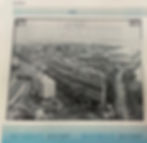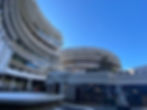Funkstown: The Watergate Break-In at 50
- Frank Leone
- Jun 14, 2022
- 3 min read
By Frank Leone
June 17, 2022 marks the 50th anniversary of the Nixon campaign break-in at the Democratic National Committee offices at the Watergate. The incident started a process that led to the only resignation of an American president, changed politics and the press forever, and made Foggy Bottom’s “Watergate” a household name. The Watergate Complex comprises three Cooperative apartment buildings (Watergate East, West and South), two office buildings (2700 Virginia Ave. and 600 New Hampshire Ave.), the Watergate Hotel, stores, and a landscaped park, which covers 70% of the 9.5 acre site. It is listed on the national register of historic places (2005), due to its innovative design by Italian Modernist architect Luigi Moretti, landscaping by Boris Timechenko, and the notoriety of the scandal. Its history includes controversies, but it remains one of the most prestigious addresses in Washington.

But let’s start with what the Nixon White House described as a “third-rate burglary.” The DNC – lured by low rates - was one of the first tenants to move into the Watergate 2700 Office Building in 1970. Five people hired by Nixon’s Committee to Reelect The President broke into the DNC’s sixth floor office as part of a bugging operation. Thanks to alert security guard Frank Wills, the burglars were arrested and the trail eventually lead back to the White House, resulting in Nixon’s resignation on August 9, 1974. Watergate became internationally known and the suffix “-gate” was applied to numerous political scandals. (Watergate even got a mention on Stranger Things season 4.)
The story of the Watergate Complex begins in 1858 when Washington Gas Light Company built its manufactured gas plant on the site, its smoke contributing to the area becoming known as “Foggy Bottom.” See https://www.foggybottomassociation.org/post/funkstown-no-7-washington-gasworks-putting-the-fog-in-foggy-bottom. By 1947, natural gas had replaced manufactured gas and WGL closed its plant and sought to sell the now valuable property. In 1955, the property was purchased by a syndicate headed by Washington Football Team owner George Preston Marshall who envisioned a Rockefeller Center-type development from 24th St. to the River. The group built Potomac Plaza – the first of the new buildings in the area, but then ran out of resources.
The property was bought by an Italian real estate company Societa Generale Immobilare (SGI), which brought in Moretti to design a self-contained “town within the city.” The modern curvilinear design reflected and maximized views of the nearby Potomac River and required an early use of computer-aided architectural design. The buildings are constructed of re-enforced concrete faced by quartz/marble aggregate. Trustees of the Kennedy Center and others raised concerns about the size and scale of the design, but those issues were resolved over time and the complex became first private initiative Planned Urban Development (PUD) in Washington, D.C.. The buildings opened between 1965 and 1971.
The Complex developers chose the name Watergate early in the process. The construction of Memorial

Bridge included a series of steps leading from the river (water) and providing an entrance (gate) to the mall (b. 1932). Those steps were used for seating for concerts offered from a barge on the river and the area became known as Watergate. The concerts started in 1935 and ended in 1965, when noise from the airplanes at National Airport drowned out the music. The name migrated north to the Watergate Inn, which opened in 1942 serving Pennsylvania Dutch style food (demolished in 1966 to make way for the Kennedy Center).
The Watergate Hotel, where the burglars stayed the night before the break-in has gone through a number of changes of the years. Most notably from 1979 to 1996, it hosted Jean-Louis Palladin’s extraordinary Jean-Louis at the Watergate restaurant, featuring perhaps the greatest wine cellar in the country. The Hotel was closed from 2007 to 2016, and almost converted to a co-op, but it is now open and features lobby and roof-top bars and restaurants.

In its heyday, the Complex featured four shopping areas, with 60+ stores including Yves St. Laurent, Gucci, and Pierre Cardin as well as Safeway and CVS. Walk into the courtyard and you will still find excellent shops including Dale Johnson’s Watergate Gallery & Frame, Watergate Pastry, as well as Tazza across from the Kennedy Center. We can hope for a revival of retail at Watergate.
Sources: Rodota, Joseph, The Watergate: Inside America’s Most Infamous Address, William Morrow: 2018; D.C. Preservation League, Watergate Complex Nomination, https://historicsites.dcpreservation.org/items/show/659; Goode, James M. Best Addresses: A Century of Washington's Distinguished Apartment Houses, Smithsonian Books: 1988; FBA History Project, https://www.foggybottomassociation.org/history-project
